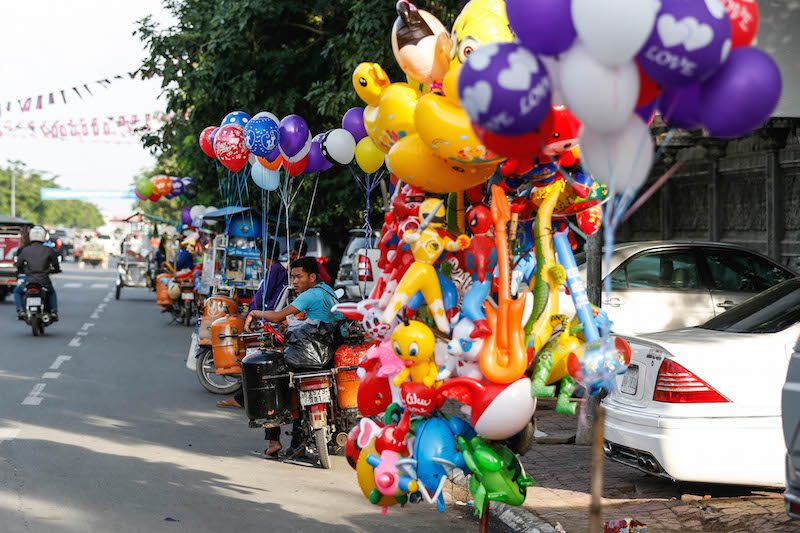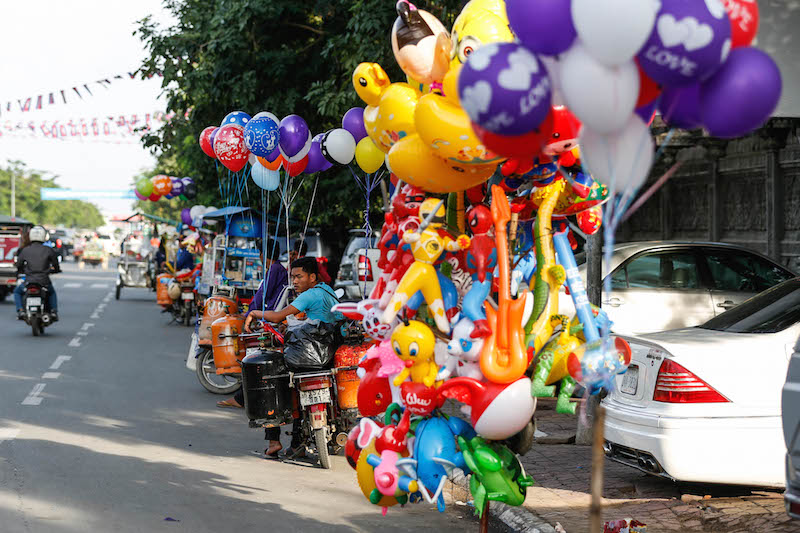Balloons are back.
Two months ago, authorities banned balloon vendors from tourist-dense areas of Phnom Penh like the riverside, the Royal Palace and Independence Monument, saying the vendors’ gas tanks could trigger explosions, stampedes and acts of terrorism.

But for vendors who ply Sihanouk Boulevard, the prohibition has amounted to little more than a cat-and-mouse game with authorities.
“Every day, three times a day,” police and security guards come and shoo 25-year-old vendor Ar Eng away, he said on Thursday. “Every time I get kicked out, I have to pay 1,000 riel,” or about $0.25, he said, eyeing a passing military police officer.
Other balloon sellers on the block—many of whom are Mr. Eng’s relatives from Svay Rieng province—laughed off the daily payment and routine block clearances.
“It doesn’t matter if you make any sales or not that day—they must get it,” Norn Smey, 23, said of the 1,000 riel he said he pays a Chamkar Mon district police officer he knew only as “Kheang.”
“He comes and asks us to pay for our place and then, later, they kick us out,” Mr. Smey said, adding that the cycle repeats itself up to three or four times a day.
“I don’t know why they are collecting it,” he said, as his inflatable “Love” and “Happy Birthday” wares bobbed in the wind.
Chamkar Mon district police chief Khin San hung up on a reporter when asked about the balloon crackdown.
City Hall spokesman Mean Chanyada said it was only the gas tanks that were barred from the area—not the balloons or their vendors.
“It’s not about balloons. We prohibit only those vendors with gas tanks…because it affects security,” he said, adding that “there were 400 gas explosions in 2014 because of the heat.”
Vendor Ken Tina said that authorities “aren’t too strict” about the ban and, unlike other vendors in the area, said he had never been asked for payments.
“When they kick me out, I just wait and come back” 10 to 15 minutes later, the 29-year-old said. “They told me it’s a prohibited place, a tourist place…. They told me that I was too close to the prime minister’s house and [the tanks] might explode.”
The concern may not be unfounded. A global shortage in helium—the inert, noncombustible gas widely used to fill balloons—has resulted in some vendors turning to the far more inflammable hydrogen gas.
Two children in Bangalore, India, were injured last year when a batch of balloons exploded at a birthday party, according to The Times of India. And nearly 100 students were injured in China when some 1,600 small balloons ignited at a school ceremony in 2007, Xinhua News Agency reported.
Soe Pann, a 25-year-old university student milling with friends near the vendors, seemed unconcerned about her safety.
“Have there been explosions before?” she asked. “I’m not worried because I have never seen any explosions.”
(Additional reporting by Ben Paviour)




